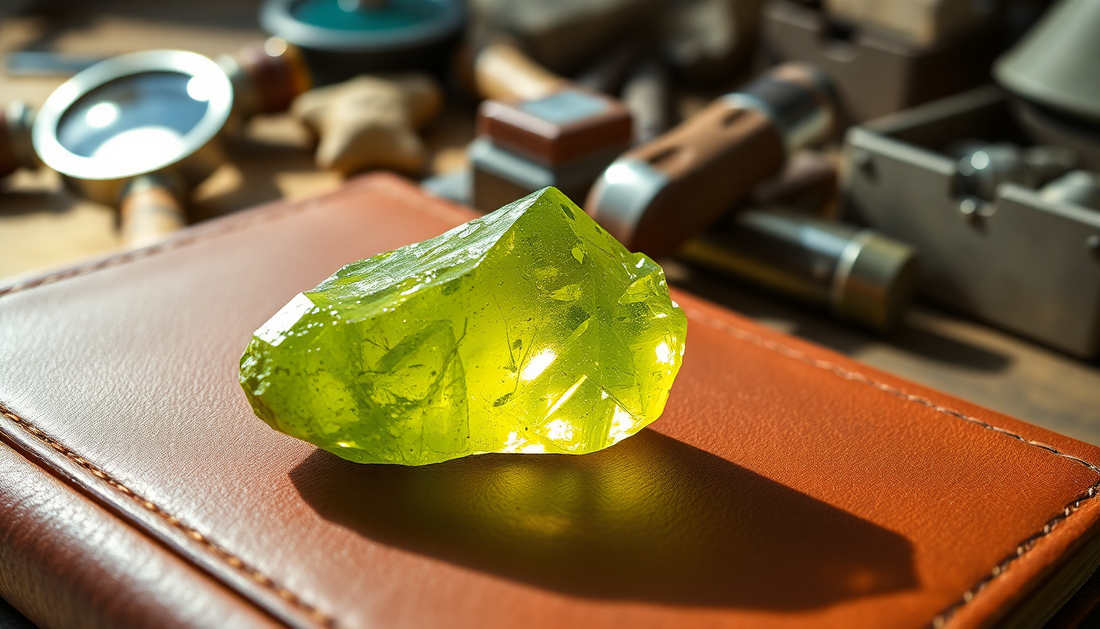
Unraveling the Beauty of Rough Peridot: A Gemstone Enthusiast's Guide
Share
Peridot, a captivating gemstone that has captivated the hearts and minds of jewelry enthusiasts for centuries, is a true wonder of nature. Hailing from the depths of the earth, this vibrant green gem is prized for its unique and mesmerizing appearance. In this comprehensive blog post, we will delve into the world of rough peridot, exploring its origins, characteristics, and the fascinating process of transforming it into the stunning gemstones we cherish.
The Allure of Rough Peridot
Peridot, a member of the olivine family, is a gemstone that has been revered for its exceptional beauty and rarity. Unlike many other gemstones that are found in the earth's crust, peridot is believed to have originated deep within the mantle, the layer of the earth that lies between the crust and the core. This unique geological origin gives peridot a distinct and captivating appearance, with its rich green hues ranging from pale yellow-green to deep, almost olive-like shades.
One of the most fascinating aspects of peridot is its raw, uncut form, known as rough peridot. These unpolished, uncut stones possess a rugged, natural beauty that is truly mesmerizing. Rough peridot can take on a variety of shapes and sizes, from small, delicate crystals to larger, more dramatic formations. Each piece is a unique work of art, shaped and sculpted by the immense forces of the earth over millions of years.
The Journey of Rough Peridot
Peridot is primarily found in a few select locations around the world, with the most significant deposits located in the United States, Pakistan, and Myanmar. The process of mining and extracting rough peridot is a fascinating and challenging endeavor, requiring specialized techniques and equipment to navigate the often rugged and remote terrain.
In the United States, for example, the most famous source of peridot is the Kilbourne Hole in New Mexico. This unique geological formation, created by a volcanic eruption, is home to a wealth of peridot crystals that have been exposed over time. Miners must carefully excavate the site, using a combination of hand tools and heavy machinery to extract the precious stones.
Similarly, in Pakistan, the Skardu region is renowned for its peridot deposits, which are found in the remote and mountainous Karakoram range. Here, local miners must brave treacherous terrain and harsh weather conditions to uncover the elusive gemstones, often working in small, family-owned operations.
Preparing Rough Peridot for Faceting
Once the rough peridot has been extracted from the earth, the next step in the journey is to prepare it for faceting, the process of cutting and polishing the stone to enhance its natural beauty. This is a delicate and intricate task, requiring a deep understanding of the unique properties and characteristics of peridot.
The first step in the process is to carefully examine the rough peridot, identifying any flaws, inclusions, or areas of weakness that may affect the final cut. Skilled gemologists and lapidaries use a variety of tools and techniques, including microscopes and specialized cutting equipment, to carefully assess the stone and plan the optimal cutting pattern.
Next, the rough peridot is carefully cut and shaped, using a combination of manual and automated tools. This process involves carefully removing material from the stone, creating precise facets and angles that will maximize the stone's brilliance and fire. Throughout this process, the gemstone cutter must be mindful of the unique properties of peridot, such as its tendency to cleave or fracture under certain conditions.
Once the cutting process is complete, the peridot is then polished, using a series of increasingly fine abrasives to create a smooth, lustrous surface. This final step is crucial, as it is what gives the gemstone its signature sparkle and shine, transforming the rough, uncut stone into a dazzling, faceted gem.
The Diverse Colors of Peridot
One of the most captivating aspects of peridot is the wide range of colors it can exhibit, from pale yellow-green to deep, almost olive-like shades. This diversity is a result of the complex geological processes that give rise to peridot, as well as the presence of various trace elements within the stone.
The most common and sought-after color of peridot is a rich, vibrant green, often described as a "lime" or "grass" green. This color is the result of the presence of iron within the stone, which gives peridot its distinctive hue. However, peridot can also be found in shades of yellow-green, olive-green, and even brownish-green, depending on the specific composition of the stone.
Interestingly, the color of peridot can also be influenced by the conditions under which it is formed. Peridot that is found in volcanic environments, for example, may have a slightly different color than peridot that is found in metamorphic or sedimentary settings. This diversity of color is part of what makes peridot such a fascinating and captivating gemstone.
The Enduring Allure of Peridot
Peridot has been prized for its beauty and rarity for centuries, with its history stretching back to ancient civilizations. In fact, some of the earliest known examples of peridot jewelry date back to the ancient Egyptians, who were known to adorn their temples and tombs with the vibrant green gemstone.
Today, peridot remains a highly sought-after gemstone, prized by jewelry enthusiasts and collectors alike. Its unique and captivating appearance, combined with its relative rarity, make it a true treasure of the natural world. Whether in its raw, uncut form or expertly faceted and polished, peridot continues to captivate and inspire, reminding us of the incredible beauty and diversity of the earth's natural wonders.
As we continue to explore and uncover the secrets of this remarkable gemstone, we can only imagine the countless stories and mysteries that lie waiting to be discovered. From the depths of the earth to the heights of human creativity and craftsmanship, the journey of peridot is one that is truly worthy of our wonder and admiration.